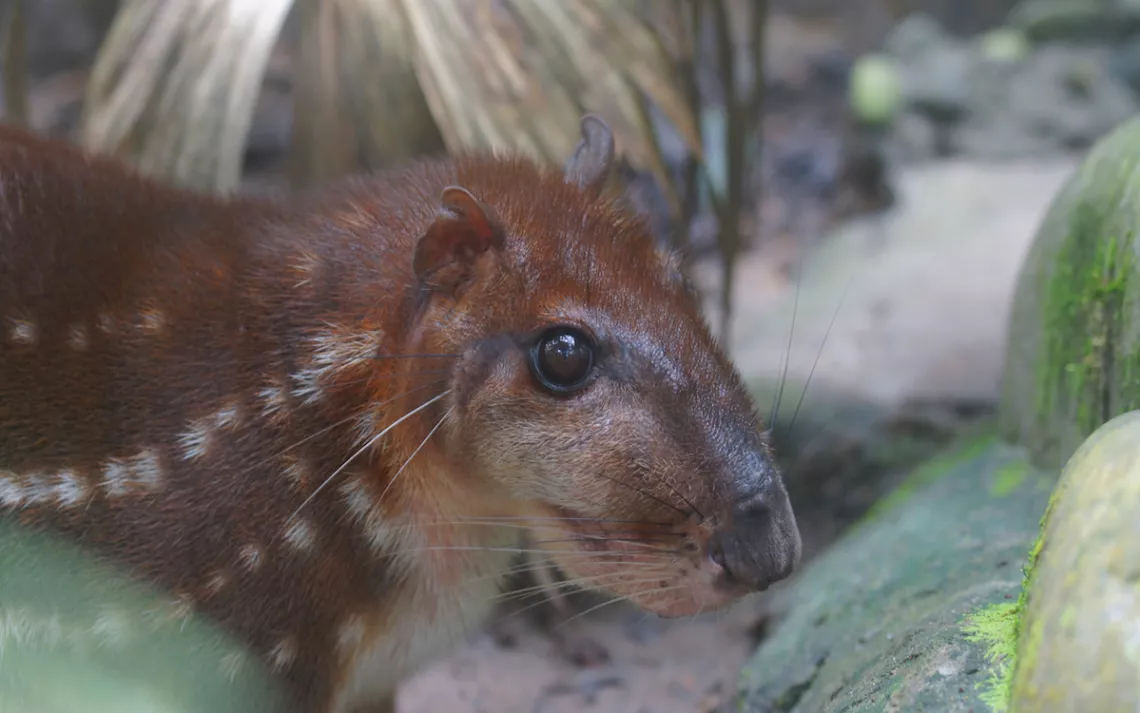Saving the Amazon’s Paca
Scientists and hunters team up to protect an important food source

Photo by alejomiranda/iStock
Pacas are easiest to catch when the moonlight is dim. Amazonian hunters, like those who live in the Amanã Sustainable Development Reserve in Brazil, leave their communities on the darkest nights and glide silently through the forest in nonmotorized canoes, looking for prey.
They carry a flashlight—not to light the way, but to locate and dazzle these large, hairy rodents. Caught in the bright beam, the pacas’ eyes gleam red, revealing the animals’ hiding places along the banks of the river.
Pacas are one of the most popular meals for communities throughout the Amazon, who rely on fish and bushmeat for sustenance. Children grow up learning how to track down and kill these strange animals. During the daytime, hunters use dogs to force the rodents out of their burrows and into the river, where someone in a canoe waits with a machete or a stick to finish the job. These are the hunting techniques that Hani El Bizri observed when he came to the Amazon in 2010 to study the sustainability of paca populations. At the time, he was a researcher at the Mamirauá Institute.
Pacas are the second-most hunted animal in the reserve, after a piglike mammal called the white-lipped peccary. They provide an important source of protein to the 4,000 people who live there. While overhunting is not an existential threat to the pacas, local extinctions in the immediate vicinity of a community can be a problem, forcing residents to hunt across a larger area or go hungry.
“Of most concern to me is whether local people have enough food. They hunt this species a lot, and they rely on them for their food security. That is why we should develop efficient methods to monitor and manage their populations,” says El Bizri.
Scientists had made previous efforts to monitor paca populations, but they had been unsuccessful. They tended to use Tomahawk traps to try to catch pacas in order to study them, a scientifically orthodox but not very efficient method. To date, only two projects relying on this method have succeeded in catching a single animal. Both were conducted in the 1980s, in an area of Panama known for its dense population of pacas.
El Bizri sensed an opportunity to collaborate with the communities in the reserve, drawing upon their traditional knowledge to improve his own scientific methods and helping them ensure the survival of their food supply in turn.
Since then, El Bizri has met, lived, and worked with communities throughout the Amanã Reserve, learning how to track down and capture these elusive creatures. He worked with locals—in particular, two brothers, Luiz Washington da Silva Araújo and Wigson da Silva Araújo—to train two hunting dogs to stop chasing after every animal they heard and to target pacas specifically. Together, they codified this approach into a standardized scientific method.
It turned out to be vastly more effective than using Tomahawk traps as well as more cost-efficient. It allowed El Bizri to amass a rare dataset on paca populations in the Amazon and to study the paca’s reproductive system–and, according to one community member, it provided a rare opportunity to prove that their time-tested methods also worked “on paper.” Their joint efforts have yielded some alarming findings, including that pacas are more likely to be hunted while pregnant.
El Bizri is hardly alone in his concern over the declining availability of bushmeat, nor are pacas the only species vulnerable to the threat of overhunting.
In 2016, a group of 15 academics warned, in a Royal Society journal, that an increase in bushmeat hunting is currently threatening 301 land mammals with extinction and endangering the food security of hundreds of millions of people across parts of Africa, Asia, and South America.
But efforts to protect biodiversity have, conversely, led to instances of policies that ignore the needs of the local people and can damage efforts to manage and preserve wildlife. Brazil, for instance, has effectively banned hunting through complex and contradictory legislation—an approach which does little to prevent this necessary and traditional activity in the vast Amazon rainforest, instead forcing communities to practise it illegally and unsustainably.
In addition, government policies to support poor rural communities have, in some cases, lead to a worsening diet for those that do have access to urban areas, explains Flavia Mori, a researcher in health, food, and nutrition at the University of São Paulo. People who receive financial support “tend to abandon their crops and their traditional practices and shop in urban cities for industrialized food,” she says. “The substitution of hunting and farming in these regions is neither sustainable nor has the nutritional value of the meat of endangered species. If you expand agricultural activities, you put those species in more danger, because you change the environment, and they start to invade urban areas and get killed.”
With input from community members, El Bizri is using his findings and data to create a paca management plan that he hopes will be voluntarily adopted across the Amanã Reserve, and eventually be adopted as a public policy in Brazil. This could include hunting only at certain times of the year, or across a rotating selection of areas, to allow populations to recover between hunts.
For El Bizri, it has been important to recognize the contribution that traditional knowledge played in his work, and especially the two brothers who accompanied him through the forest and in his canoe. In a paper he published in 2015 in Wildlife Biology detailing his findings, he listed Luiz and Wigson da Silva Araújo as coauthors.
 The Magazine of The Sierra Club
The Magazine of The Sierra Club



